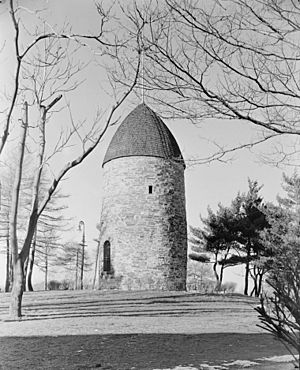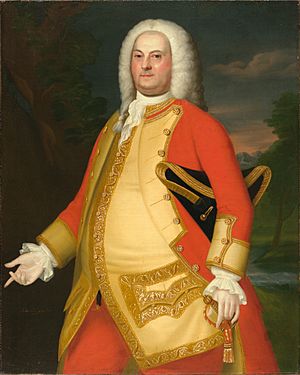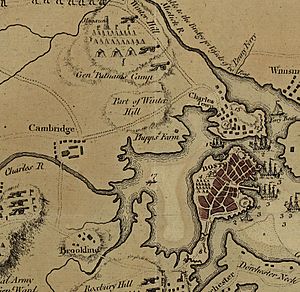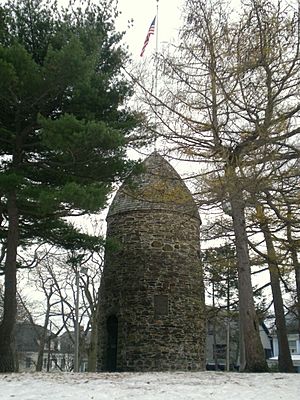Powder Alarm facts for kids
Quick facts for kids Powder Alarm |
|||||||
|---|---|---|---|---|---|---|---|
| Part of the American Revolutionary War | |||||||
 The Old Powder House in Somerville, Massachusetts, as it stood in 1935, atop the hill at Nathan Tufts Park overlooking Powder House Square |
|||||||
|
|||||||
The Powder Alarm was a big reaction from colonists when British soldiers took gunpowder from a storage building. This happened on September 1, 1774. General Thomas Gage, the British governor of Massachusetts, ordered the soldiers to do this.
When news spread, many colonists thought war had started. They heard rumors that people had been hurt. Thousands of Patriot militiamen quickly headed towards Boston and Cambridge. Mobs of angry colonists forced Loyalists (people loyal to Britain) and some government officials to run to the British Army for safety.
Even though it turned out to be a false alarm, the Powder Alarm was very important. It made leaders on both sides more careful. It was like a practice run for the real fighting that happened later at the Battles of Lexington and Concord. After this event, both the British and the colonists tried harder to control weapons and gunpowder. The British wanted to keep military supplies safe. The Patriots wanted to get them for their own use.
Contents
Why the Alarm Happened

In 1772, many of the thirteen British colonies started to work together. They formed groups called Committees of Correspondence. These groups helped different towns and colonies share news. They also helped them plan how to react to unpopular British laws.
One of these laws was the Boston Port Act. It closed the port of Boston in 1774. This was a punishment for the Boston Tea Party. The colonists in Massachusetts had not yet formed an army. But they said they would support Boston "at the risk of our lives and fortunes."
General Thomas Gage became the military governor of Massachusetts in May 1774. His job was to make sure the unpopular Intolerable Acts were followed. These were laws passed by the British Parliament. Gage wanted to avoid war. He thought the best way was to secretly remove military supplies. He wanted to take them from storage places in New England. Secrecy was very important. Gage worried that if his plans leaked, Patriots would take the supplies first.
The British army had supplies in many places. Some were in forts with small groups of soldiers. Others were just locked storage buildings called magazines. Most of the gunpowder belonged to the local government. Some belonged to individual towns.
One locked storage building was near Boston. It was in what is now Powder House Square in Somerville. This building was controlled by William Brattle. He was the leader of the local militia. Brattle told Governor Gage on August 27 that only the provincial (King's) powder was left there. The towns had already taken their own supplies. Gage decided this powder needed to be moved to Boston for safety.

The British Expedition
On August 31, Gage sent the local sheriff, David Phips, to William Brattle. Phips had orders to take the provincial powder. Brattle gave Phips the key to the powderhouse. Gage also ordered soldiers to get ready for action the next day. Local people noticed this activity.
Around this time, General Gage lost William Brattle's letter. Many people believed it was dropped. News of its contents spread quickly. Many thought it was a warning to Gage to take the powder before Patriots could get it.
Early on September 1, about 260 British soldiers set out. They were from the 4th Regiment. They traveled secretly up the Mystic River from Boston to Winter Hill in Somerville. From there, they marched about a mile (1.6 km) to the Powder House. This was the largest gunpowder storage in Massachusetts.
Sheriff Phips gave the soldiers the keys. After sunrise, they removed all the gunpowder. Most soldiers then went back to Boston the way they came. But a small group marched to Cambridge. They took two cannons and brought them to Boston. The cannons and powder were then taken to Castle Island. This was a British stronghold.
British Response to the Alarm
Gage was surprised by how many colonists reacted. He delayed a plan to take supplies from Worcester. He gathered his troops in Boston. He also asked London for more soldiers. He wrote, "if you think ten thousand men sufficient, send twenty."
Some in London thought Gage's request was too much. There were only 12,000 troops in Britain at the time. But Gage did get 400 more Marines. He later started planning more seizures of supplies. He also made Boston stronger with more defenses.
Colonial Response to the Alarm

After the Powder Alarm, militias in New England became more careful. They wanted to know more about Gage's plans. Paul Revere was very important in sharing this information. He lived in Boston and knew people from all walks of life. He was also a well-known Patriot who helped organize things.
Colonists Get Organized
On September 21, Patriot leaders met in Worcester. They told towns to organize their militias. They wanted a third of them to be special companies called minutemen. These soldiers would be ready to march at any moment. They also set up a system of riders and alarms. This system was very important later at Lexington and Concord.
In October, the Massachusetts legislature met even though the British had tried to stop them. They called themselves the First Provincial Congress. They created a Committee of Safety. This group suggested that a quarter of the militia should be minutemen. They also decided to store military supplies away from the coast. This would make it harder for the British to take them. The biggest supply areas were in Concord and Worcester.
Portsmouth Alarm
In early December, the British decided to stop sending weapons to North America. They also wanted to secure all remaining supplies. On December 12, Paul Revere got information. It said that the British were about to take supplies from Fort William and Mary in Portsmouth, New Hampshire.
Revere rode from Boston to Portsmouth the next day. He warned the local Patriots. They quickly raided the fort on December 14. They removed its supplies. Revere's information was not completely right. The British had thought about an operation, but had not ordered it yet. British ships with troops arrived three days after the fort's supplies were gone. The first ship arrived on December 17. A local Patriot pilot guided it into shallow water at high tide. This made the captain very angry.
Gunpowder was also taken from forts in Newport, Rhode Island, Providence, Rhode Island, and New London, Connecticut. Loyalists called it "the King's powder." Patriots called it "the militia's powder." This powder was given to militias in towns away from the coast. Cannons and other supplies were also secretly moved out of Boston and Charlestown.
Salem Confrontation
On February 27, 1775, the British ship HMS Lively brought about 240 British soldiers. They were from the 64th Regiment. They came to take weapons in Salem, Massachusetts. A small crowd stopped them. They raised a drawbridge in the soldiers' path. They also made fun of the soldiers while others moved cannons to safety. People from nearby towns were called for help.
Eventually, the drawbridge was lowered. The soldiers were allowed to search the building where the cannons had been. They found nothing. They returned to their ship. A growing group of colonists marched next to them, mocking them. There were small fights, but no shots were fired.
Images for kids
See also
 In Spanish: Alarma de Pólvora para niños
In Spanish: Alarma de Pólvora para niños





